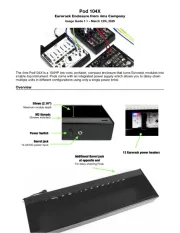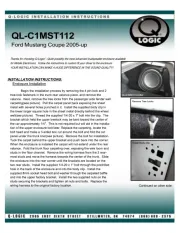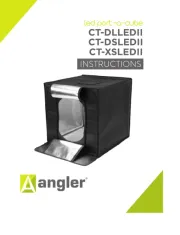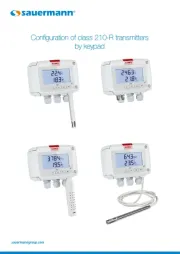4ms VCA Matrix Handleiding
4ms
Niet gecategoriseerd
VCA Matrix
Bekijk gratis de handleiding van 4ms VCA Matrix (8 pagina’s), behorend tot de categorie Niet gecategoriseerd. Deze gids werd als nuttig beoordeeld door 93 mensen en kreeg gemiddeld 4.6 sterren uit 47 reviews. Heb je een vraag over 4ms VCA Matrix of wil je andere gebruikers van dit product iets vragen? Stel een vraag
Pagina 1/8

4ms VCA Matrix
Eurorack Module User Manual v1.0
The VCA Matrix from 4ms is a playable 4x4 matrix of 16 VCAs. The four audio/CV inputs can be routed and
mixed in any combination to the four outputs, with independent CV control of each VCA.
Features
•4 CV/audio inputs and 4 outputs (buffered and dc-coupled)
•Full range (0Hz - 20kHz) for both Control and Signal inputs, allows for AM effects, etc.
•16 VCA's using high quality SSM chips
•Attenuation/gain range from -100dB (mute) to 0dB (unity). Up to +20dB boost with trimpot adjustment.
•Playable surface with 16 latching Mute LED buttons, used to mute each VCA individually (Mute button
disconnects Control jack and Level knob, and fully attenuates the VCA)
•LED button brightness indicates amount of attenuation and Control CV signal
•16 Control jacks for VCA level control
•16 Level knobs attenuate the incoming Control signals. The Level knobs act as manual level controls
when nothing is plugged into the Control jack
•Exponential VCA response in low control voltage range, pseudo-log response in higher voltage range.
•"Soft Limit" effect limits gain to prevent clipping, while still responding to higher Control voltages with
more "punch" and wider pulses
•Matrix Expandability: VCA Matrices can be connected to form a larger matrix using headers on the back
(4x8, 8x8, 12x4, etc)
•Control Expandability: 16-pin header on back side of PCB allows an external device to control all VCAs:
e.g. patch recall, patch sequencing, preset patterns such as quadrature panning, etc.
•Suitable as a 4x4 mixer, splitter, dynamic signal router, limited waveshaper, etc.
Dimensions
•26 HP Eurorack format module
•1.6” (40mm) deep

How to Use the VCA Matrix: Examples
Basic usage: Simple 4x4 Mixer
Simply by running up to four inputs into the Signal Inputs and running the four outputs to different destinations,
you can use the Level pots and Mute buttons to route the inputs in any amount/combination to the outputs.
Although seemingly trivial, this is often a good way to start using the VCA Matrix while creating a patch. As your
patch evolves, you will start plugging into the Control jacks, mult'ing/stacking inputs and outputs, creating
feedback loops, and generally using the VCA Matrix to weave your signals into a patch.
Basic usage: Keeping your modulations related to each other
Let's say you're making a patch and you want to modulate four different parameters using four different
modulation sources. You want all the modulations to be related to each other but not identical. Simply by using
the VCA Matrix as a 4-in, 4-output mixer, you can quickly have synchronicity between your four modulation
destinations.
Now take it a step farther by running other modulations (e.g. touch pads, LFOs, etc) into the Control jacks to
control each modulation mix amount. For instance, run the four pressure outputs of of a Pressure Points into four
Control jacks and you have a touch surface mixer. Or use the PP to trigger four envelopes... etc.
Feedback Mixer
Taking the last example one step further, you can take one of the outputs (mult'ing or stacked if necessary) and
plug that back to one or more of the Control inputs on the VCA Matrix. Continue routing outputs back into Control
inputs, perhaps running them through other modules first. Feedback loops can quickly spiral exponentially into
chaos or flat-lined CV, so using the Mute buttons and carefully setting the Level pots is essential.
Amplitude Modulation (AM)
Since the VCA Matrix operates in the full audio range for both the Control and Signal inputs, you can easily
achieve Amplitude Modulation (“cross modulation”) effects by running an audio frequency into the Signal input
and another audio signal into a Control input. For example, run VCO #1 into Input A. Now run a VCO #2 into
Control input A-1. On output 1 you'll hear a rich sound based on both input frequencies. Adjust the VCOs and
play with the A-1 Level pot to hear the range of textures possible.
Tip: Run the Control VCO #2 through an unused channel on the VCA Matrix (e.g. Input B), and run an envelope
with a sharp attack into the associated control jack (e.g. Control input B-2). Patch the output (e.g. Output 2) into
the original Control Input (e.g. A-1). Now the AM effect will be modulated in a percussive way.... and.... you can
play with various associations such as bringing some of the Control VCO into Output 1 (using B-1). Keep
extending this patch in the same way to have another VCO#3 modulate VCO#2, with a different envelope... etc.
Voltage Controlled Signal router (Quadrature)
In quadrature panning, one or more input signals is routed to four outputs (which could be four speakers),
usually using 4 LFO CVs that are each 90 degrees out of phase.
For example, the MATHS can be used to generate quasi-quadrature LFOs, by following the “Whirly Bird”
example in the MATHS manual. Alternatively, the Malekko/Wiard Oscillator has a variable phase output, so it can
be used to generate two 90-degree out-of-phase triangle waves. From either module, mult/stack both triangle
signals and invert them, and then run the inversions into A-3 and A-4. Run the original non-inverted triangle
waves into A-1 and A-2. With the Level pots on Row A turned up, you should see the lights swell in a quadrature
fashion. You may wish to level-shift the Oscillator's outputs using the Malekko 8NU8R's “red” mode, a MATHS,
the Bubblesound LvL+RM or any number of other level shifter modules.
Page 2

Examples (continued)
Hybrid Patch: 1V/Oct VCO controller and Cross Modulator
This patch requires three VCOs with 1V/oct inputs and one CV source (e.g. from a sequencer, a keyboard, or
perhaps random stepped voltages). Part of the VCA Matrix is used for 1V/oct routing and part is used for audio
mixing. The rest of the matrix allows for feedback-loops/cross modulation. The patch may seem complicated to
grasp at first, so we'll build it step-by-step:
Start by Muting everything. Patch the three VCO outputs into the VCA Matrix Inputs B, C, and D. Run output 4 to
your output mixer. Unmute B-4, C-4, and D-4 and you can now mix the three VCO audio outputs by using the
Level pots B-4, C-4, and D-4. Tune your VCOs if you want.
Patch the CV source into Input A. Run Outputs 1, 2, and 3 into the 1V/oct inputs of the three VCOs. Unmute A-1,
A-2, and A-3 and fine-tune the pitches with the Level pots A-1, A-2, and A-3 so that the oscillators sound good
together. See section on Precision Tuning for more information.
Here's where it gets interesting... By unmuting one of the 9 buttons on rows B, C or D and columns 1, 2, or 3,
you will be feeding one of the VCO outputs back into the 1V/oct of another VCO. The result is a web of VCOs
cross modulating each other. The Level pot fine-tunes the effect. Play the Mute buttons, and try running
envelopes into the Control jacks to add motion to the timbres.
Another variation is to use two CV sources into Inputs A and B, and only two VCOs into Inputs C and D. You can
use the Mute buttons and Level knobs to play between the two CV sources and independently setting the level
sent to each VCO.
Waveshaper
Most exponential VCA's can convert a linear control voltage into an exponential signal. This patch simply
involves running a linear waveshape (e.g. a triangle wave) into a Control jack on the VCA Matrix, and running a
constant DC voltage into the Signal jack. The constant DC voltage controls the amplitude of the output. To start,
keep the amplitude of the triangle wave attenuated (around 3V) and use a uni-polar (positive only) triangle wave.
See Figure 1.
The VCA Matrix can also use its pseudo-log response at the upper range of Control voltages to convert a linear
waveshape into a sine wave approximation. Use the same patch as above, but bring the DC-offset of the triangle
wave up so that it starts to soft-limit the VCA Matrix. Adjust the amplitude of the triangle wave as well (you can
use the VCA Matrix's Level pot). See Figure 2.
Control jack signal is top wave (triangle). Output jack is bottom wave.
Steady DC is run into Input jack (not shown). Middle plot is FFT analysis of output.
FIGURE 1: FIGURE 2:
Triangle to exponential conversion using exponential
portion of VCA Matrix's response
Triangle to near-sine conversion using the VCA
Matrix's soft limiting pseudo-log response
Page 3
Product specificaties
| Merk: | 4ms |
| Categorie: | Niet gecategoriseerd |
| Model: | VCA Matrix |
Heb je hulp nodig?
Als je hulp nodig hebt met 4ms VCA Matrix stel dan hieronder een vraag en andere gebruikers zullen je antwoorden
Handleiding Niet gecategoriseerd 4ms

2 Augustus 2025

4 Mei 2024

3 Augustus 2023

3 Augustus 2023

24 Juni 2023

16 Juni 2023

16 Juni 2023

2 Juni 2023

19 Mei 2023

15 Mei 2023
Handleiding Niet gecategoriseerd
- Cocraft
- Schmidt & Bender
- Gumotex
- Cricut
- Ferroli
- Polk
- Polarlite
- Iadea
- Duro Pro
- Klark Teknik
- Haws
- ASI
- Robust
- Selfsat
- DiversiTech
Nieuwste handleidingen voor Niet gecategoriseerd

18 September 2025

18 September 2025

18 September 2025

18 September 2025

18 September 2025

18 September 2025

18 September 2025

17 September 2025

17 September 2025

17 September 2025